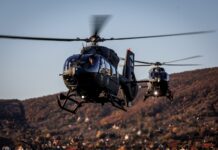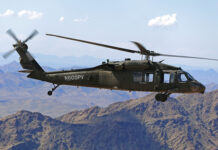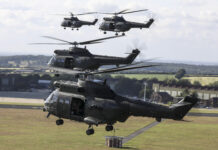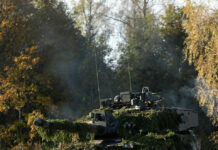The UK Ministry of Defence (MoD) finally issued an invitation to negotiate for its New Medium Helicopter requirement in February, but the history of the programme suggests that the fruits of this procurement initiative could still be years away.
On 27 February 2024 the starting gun was fired on the next phase of the UK’s New Medium Helicopter (NMH) programme when the UK MoD issued an invitation to negotiate (ITN) for the requirement, with responses to the ITN due to be received by 30 August.
The ITN downselected three contenders – Airbus Helicopters UK with the H175M, Leonardo Helicopters UK with the AW149 and Lockheed Martin UK offering the S-70M Black Hawk – for a requirement that is now largely a programme to replace the Puma HC2 fleet currently operated by the Royal Air Force (RAF). The aim of the NMH programme, according to the MoD’s 27 February statement, is to “deliver up to five rotary-wing requirements using a single aircraft type”, although the MoD did not specifically state what those five requirements are.
While the ITN was welcomely received as a sign of progress in the programme, the bidders are likely to believe that the race to fulfil the NMH requirement will continue as a marathon rather than a sprint.
The original NMH requirement
When the NMH programme was first announced by the UK MoD in March 2021, the MoD announced that it was to procure up to 44 aircraft in a contract worth GBP 0.9-1.2 billion (EUR 1-1.4 billion) that “intends to rationalise existing multiple rotary-wing requirements into one platform type, maximising commonality in order to improve efficiency and operational flexibility.
“NMH, the MoD stated, “will provide a common medium-lift, multi-role helicopter, fitted for, but not with, specialist Mission Role Equipment and able to operate in all environments in support of defence tasks.”
NMH at the time covered four distinct rotary-wing requirements. As well as replacing the fleet of 23 RAF Puma HC2s operated by No 33 and No 230 squadrons out of RAF Benson in Oxfordshire from 2025, the programme was also intended to replace five Bell 212s serving with the Army Air Corps’ (AAC’s) No 667 Squadron in Brunei, three Griffin HAR2s operated by the RAF’s No 84 Squadron out of RAF Akrotiri on Cyprus (tasked with search and rescue), and six special-forces-roled AS365 N3 Dauphin IIs operated by the AAC’s No 658 Squadron from the Special Air Service (SAS) barracks at Credenhill in Herefordshire.
Beyond procuring aircraft, the NMH contract was also to “include the provision of training capabilities and a maintenance/spares package as well as design organisation scope”, according to the MoD. The relatively ambitious in-service date for the new helicopters was given as 2025, suggesting that an already-existing airframe was likely to be chosen.

(Credit: Crown Copyright 2023)
Following the initial issuing of the NMH requirement in March 2021, it was not until 18 May 2022 that the MoD released its NMH ‘Contract Notice and Dynamic Pre-Qualification Questionnaire’ (PQQ), with a deadline of 20 June 2022 for responses. The emerging bidders that passed the PQQ stage of the requirement in November 2022, in addition to the three types ultimately downselected in February 2024, also included Boeing, which was expected to offer a version of its MH-139 Grey Wolf. Offers from Bell, which was initially keen to pitch its 525 Relentless as an NMH contender, and low-cost, non-OEM contender AceHawk Aerospace, which was offering remanufactured Black Hawks featuring the Garmin G5000H digital cockpit, did not pass the PQQ.
No discernible NMH progress was then made until 13 November 2023, when the MoD published a notification of intent to procure six Airbus Helicopters H145 aircraft, along with three years of support services, to serve British forces operating in Brunei and Cyprus. This procurement, which was stated to have a value of GBP 140 million excluding VAT, thus covered two of the NMH programme’s original four requirements, with the H145s intended to enter service from 2024.
Selection of the H145 for these roles made sense from a logistical and training perspective, as three of the type are already operated under the UK armed forces’ contractor-operated Military Flying Training System regime, where the H145s are known as Jupiter HT1s.
ESD understands that, should ongoing negotiations to procure the Airbus H145s reach a satisfactory conclusion, this will allow aviation support to UK defence facilities in Brunei and Cyprus, where Puma HC2s took over from the three Griffin HAR2s on 31 March 2023, to be formally extracted from the NMH programme, allowing the ongoing NMH requirement to focus on the remaining defence tasks requiring medium rotary-wing lift support.
The three NMH contenders
The S-70M being offered by Lockheed Martin UK is based on the S-70i ‘International’ Black Hawk manufactured by Sikorsky subsidiary PZL Mielec in Poland. With a maximum take-off weight (MTOW) of 10 tonnes, the S-70M is powered by two General Electric T700-GE-701D turboshafts each developing 1,450 kW and has a top speed of 361 km/h, a range of 460 km with a 20 minute fuel reserve, a service ceiling of 6,100 m (20,000 ft) at a gross weight of 8,165 kg, and can accommodate up to 12 troops in addition to a crew of four. It has an underslung load capacity of 4,082 kg.
In bidding the Black Hawk, Lockheed Martin/Sikorsky can point to an impressive heritage for the type that includes more than 15 million flight hours flown (including five million in combat conditions), 35 user countries and a user base of more than 5,000 aircraft worldwide. The latest S-70M, moreover, features new technology that includes digital avionics and composite wide-chord rotor blades.

(Credit: PZL Mielec)
While the Lockheed Martin website asserts that “today’s Black Hawk platform has better survivability and situational awareness, and can fly higher and carry more than its predecessors and competitors ever did”, the perceived weak point in the S-70M bid is that it is based on a US helicopter when the NMH adjudication is most likely to favour a solution with a high degree of UK content and value to the domestic defence industry.
To counter this perception, in September 2023 Lockheed Martin UK launched its Team Black Hawk of UK industry partners that include Gosport-based StandardAero, Martin-Baker in Denham, Curtiss-Wright in Christchurch, Chelton in Marlow, Inzspire in Lincoln, C3iA Solutions in Poole, Nova Systems in Filton, and Ascent Flight Training & CAE at RAF Benson.
Speaking to the press at the time, Lockheed Martin UK CEO Paul Livingston asserted that around 40% of the overall value of the NMH programme would be supplied from within the UK should the Black Hawk prevail. He additionally pointed out that having a Black Hawk production line already hot in Poland would allow Lockheed Martin to “pivot more quickly to set up in the UK”.
Leonardo, meanwhile, in bidding the AW149, has the heritage of the UK’s Westland Helicopters at its Yeovil site in southern England to burnish its NMH credentials, along with the UK armed forces’ long history with the current fleet of AgustaWestland AW101 Merlin helicopter variants. The company has already assembled a supply chain of more than 70 UK companies as part of its bid and committed to at least 60% of total AW149 production occurring in the UK at “the Home of British Helicopters in Yeovil”.
In fact, at the UK’s Farnborough Air Show in July 2022 Leonardo announced that it had already started to establish an AW149 manufacturing facility at its site at Yeovil. Noting this was “a demonstration of our commitment”, Mike Morrisroe, head of UK campaigns for Leonardo Helicopters, stated at Farnborough in 2022 that the “jigs, tools and fixtures are already in place” and that Yeovil engineers are already training in Italy”. Leonardo is pledging a capability to deliver military off-the-shelf aircraft from Yeovil within 12-14 months of any contract signature.
Emphasising its position as “the UK’s only helicopter manufacturer, building military aircraft since 1947”, Leonardo points out that “more than 50% of the UK armed forces’ current frontline helicopter fleet came from Leonardo’s site in Somerset, which employs 3,300 people”.
Pointing to export potential, Leonardo has stressed as part of its bid that it has “generated GBP 6.6 billion in helicopter exports from the UK to customers in North America, Asia-Pacific, Europe and North Africa, and that it sees “an addressable export market for more than 500 medium multi-role helicopters that could be satisfied with UK-made AW149s”.

(Credit: Leonardo)
Military certified in 2014 and already in service with the Egyptian Navy, Royal Thai Army and Polish Land Forces, the AW149 has a maximum gross weight of 8,600 kg and the capacity to carry 16 fully equipped troops in addition to its crew of two, or a useful load of at least 3,800 kg, as well as an underslung load capacity of 2,800 kg, according to the Leonardo website. Powered by two Safran Aneto-1K turboshafts each developing 1,715 kW (or General Electric CT7-2E1s), the AW149 has a maximum speed of 313 km/h and a range of around 1,009 km at its maximum gross weight at 1524 m (5,000 ft) when powered by CT7-2E1s (or 913 km when powered by Aneto-1Ks). A service ceiling figure is not published on the Leonardo website but it does specify a hover out of ground effect (ISA, at a weight of 8,300 kg) at 2,893 m (with CT7-2E1s).
Regarding the AW149’s battlefield survivability, Leonardo points to key features such as a crashworthiness design allowing the helicopter’s crew and occupants to survive in 90% of all survivable crashes (according to the DEFStan 00-970 crash case specifications); a run-dry transmission that enables 50 minutes of continued flight after suffering total oil loss; and an exhaust infrared (IR) suppression system to minimise targeting by man-portable air defence systems.
Other salient AW149 features stressed by include a single-pilot, NVG-compatible, low-workload ‘glass cockpit’ and an open systems architecture that enables the rapid and low-cost integration of new equipment to meet changing military requirements.
Meanwhile, in offering the H175M – a military variant of the Airbus H175 civilian type, which entered service in 2015 – the company is continuing what they state is a “highly successful record over many years in developing dual civil and military variants of the same helicopters, evidenced by the enviably balanced market share achieved [by Airbus] in the two sectors”.
Airbus describes the H175M as “a high-capability, low-risk solution with outstanding technical and safety specifications, already operating successfully in a range of demanding roles and environments”. With an MTOW of 7,800 kg and powered by two Pratt &Whitney PT6C-67E turboshafts, the H175M can carry up to 16 fully equipped troops, or a useful load of 3,000 kg, and has a cargo sling load capacity of 2,700 kg. It has a cruising speed of 278 km/h, a service ceiling of 4,572 m (15,000 ft) and a maximum range of 1,111 km with a standard fuel tank.
An Airbus spokesman told ESD on 18 March that, “if selected by the UK, the H175M will be made and serviced in Britain by the H175M Task Force” that includes Airbus, Boeing Defence UK, Babcock, Spirit AeroSystems and Pratt & Whitney Canada. “Design work will be performed in Belfast, it will be made at Broughton in North Wales, and supported in Scotland and at military bases, creating hundreds of jobs and helping to drive competition and innovation in the UK helicopter industry,” said the spokesperson, adding that the programme “will act as a catalyst for strong export sales, enhancing the UK’s global reputation and bringing hundreds of millions into the economy”.
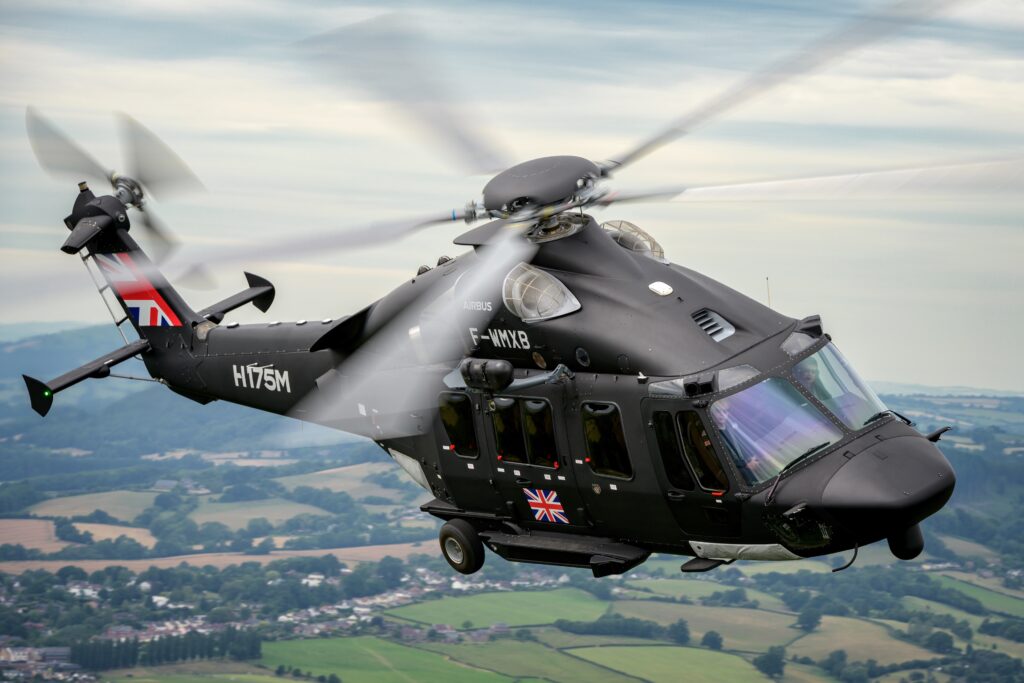
(Credit: Airbus Helicopters)
A key differentiator in the H175M bid is the aircraft’s Airbus-proprietary Helionix avionics suite: precisely the same systems used by the Juno HT1 (Airbus H135) and Jupiter HT1 (Airbus H145) helicopters employed for the UK’s contractor-operated Military Flying Training System regime, offering significant savings in time and cost on training. This advantage will become even more relevant if Airbus successfully concludes negotiations with the UK MoD to provide the six H145 helicopters selected to serve British forces operating in Brunei and Cyprus.
Beyond this, Airbus stresses that, among its other features, the H175M’s 12 m3 of cabin space is the largest on the market for a helicopter of its size, while the aircraft’s dual-duplex, four-axis automatic flight control system (AFCS) “ensures safe final approaches (particularly at low heights for prevention against terrain collision), along with a hands-off one-engine failure management mode”.
More delays in the wings?
As the three NMH contenders push their bids in earnest following the February 2024 ITN, it looks increasingly likely that this long-drawn-out programme will only get longer as the UK heads into a general election. With the latest indications suggesting the election will not be called by the ruling Conservative government until some time in the second half of 2024, the NMH programme appears likely to be delayed further by the pre-election ‘purdah’ period, which will stymie any major programme decisions once an election date is called. If, as most polling predictions strongly indicate, the Labour Party will prevail in the upcoming election, a decision on the NMH programme will most likely land on the desk of a new Labour UK defence secretary, possibly causing further delays to a programme that, while largely intended to be a military off-the-shelf procurement, has already been running for three years.
The NMH programme, as originally announced in 2021, was intended to bring new medium-lift helicopters into service in 2025, yet according to the most optimistic projections from the bidders it will take at least a year from contract signature to the delivery of any aircraft. It therefore appears inevitable that the RAF Puma HC2 fleet will have to soldier on beyond its intended service life; in September 2023 the UK MoD issued a contract to Airbus Helicopters to extend support for the Puma HC2 until March 2028.
A venerable but dwindling fleet
The RAF’s original fleet of 48 Puma HC1s first entered operational service in June 1971 – almost 53 years ago, making it the oldest rotary-wing platform in RAF service – while the first of an eventual 24 upgraded Puma HC2s was delivered back to RAF Benson for operational trials in August 2013. The final Puma HC2 was rolled out in December 2014, before the RAF returned the upgraded Puma fleet to operational service in 2015, intended to serve until 2025.
According to UK MoD figures accurate as of 1 April 2023, the RAF had a total of 18 Puma HC2s at that point, of which 13 were in service. The clear concern is that, if the number of available Pumas dwindles, the HC2 fleet’s taskings (which now also include the Cyprus mission) will have to be supplemented by other types, most likely RAF Chinook heavy lift helicopters, with a resultant strain on the serviceability of those replacement aircraft.
The Chinook fleet may have gained some respite with the announcement on 31 March 2023 that the UK MoD had finally agreed a deal with the US government under which 14 new Boeing H-47 Chinook Extended Range (ER) helicopters will be procured. However, with the extended-range capabilities of these aircraft, they are most likely to be earmarked for a special forces role, while deliveries of the new Chinooks will not occur before 2027.
Thus, the RAF and support partner Airbus will have to do their utmost to keep as many as possible of the venerable Pumas flying beyond 2025 and probably until 2028.





